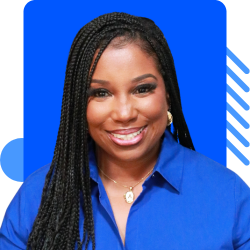Combating the racial wealth gap: 9 money moves to secure your financial future

Key takeaways
- On average, Black Americans earn less than their white counterparts, which adds extra hurdles to accumulating wealth.
- The racial wealth gap has its roots in slavery and racist policies that Black families are still catching up from.
- Navigating this racial wealth gap means people of color will have to be extra savvy about their finances.
For Black and Hispanic Americans, even personal finance can be a heartbreaking reminder of racial inequality.
Almost any way you slice it, white households have amassed more riches than Black and Hispanic households, leading to a racial wealth gap. White Americans hold more than six times the wealth of the typical Black family and almost five times the wealth of the typical Hispanic household, the Federal Reserve estimated in its 2022 Survey of Consumer Finances. White families had a median net worth of $285,000 compared with $44,900 for Black families and $61,600 for Hispanic families, according to the Fed.
That gap can grow over time. For white baby boomers who are now in their 70s, their family wealth is an average of $1.4 million more than Black families, compared to a gap of nearly $182,000 when they were in their 30s, according to analysis of Fed data by the Urban Institute.
Individuals of color often end up accumulating less wealth because they earn significantly less than their white counterparts. White individuals’ median weekly earnings averaged $1,138 in 2023, compared with $920 for Black individuals, according to data from the Bureau of Labor Statistics.
That all comes at a cost, affecting things like homeownership, investing and educational attainment — the traditional pathways for building wealth. Along the way, prudent financial steps, from saving for emergencies and retirement to investing, are all the harder.
“For a person of color, you’d still have the same challenges that everyone else has: Live within your means, manage a budget, think about your own financial future and that of your family,” says Stephanie Yates, professor of accounting and finance at the University of Alabama at Birmingham. “You’re just being held back at the starting line compared to maybe a counterpart who is not a person of color.”
From slavery to redlining: Causes of the racial wealth gap
The racial wealth gap’s roots span hundreds of years’ worth of social and political events — from slavery, the Tulsa race massacre, discriminatory GI bills and Jim Crow-era “Black codes” to race-based life insurance, gentrification and redlining. These devastating events and policies targeted everything from wealthy Black neighborhoods to Black voting districts and Black members of the military, causing tremendous hardship. They also limited Black Americans’ opportunities to accumulate wealth, impacting generations long after the passage of the Civil Rights Act.

“Not accepting the notion that Black people are ‘bad’ with money or don’t have money is key for me understanding my clients’ money stories,” says Zaneilia Harris, CFP, president of Harris & Harris Wealth Management Group. “I stand proudly on what Black American professionals have accomplished despite the challenges.”
For Black Americans, racist policies and practices are often hiding in plain sight — in the form of racially biased hiring and lending.
Naseema McElroy, founder of Financially Intentional, recalls receiving two drastically different mortgage rate offers when trying to buy a home in 2020, one of them significantly higher than the industry standard based on her excellent credit score and ability to make a down payment.
“When I called them out on the rate — with an approval for a far lower rate in hand — they tried to say they would match the rate, only to add more fees they thought I wouldn’t notice,” she says. “Even with Fair Housing laws in place, lenders still have a lot of discretion on who they waive fees for and what rates they charge individuals. More often than not, they don’t work in the favor of people of color.”
Even worse, what seemed like well-intentioned policies have sometimes worsened the issue, Yates says. The Social Security Act of 1935, for example, excluded farm workers and domestic workers from obtaining benefits, jobs that included at least 60 percent of the Black population in the U.S., according to the Social Security Administration.
“If you administer a relief system through a network that already has racial disparity, the end result is going to be more racial disparity,” Yates says. “You have to understand how we got here in order to figure out how to fix it.”
Generation after generation, Americans of color play a game of catch up
Those events all matter because they’ve set individuals of color further back for decades.
Each new generation tries to play catch-up, without as much help from the previous generation as their white counterparts. On average, just 8 percent of Black households and 6 percent of Hispanic households received an inheritance in 2022, compared with 28 percent of the average white households, according to the Urban Institute’s analysis of Fed data.
“The majority of my white clients have others in their families contributing to their finances starting in their 20s and 30s,” says Andrew Tudor, a CFP and co-founder of Alchemist Wealth, which specializes in helping Black families eliminate the racial wealth gap. “For my Black clients, that is very, very rarely the case.”
Meanwhile, Black college graduates owe $25,000 more in student loans on average than white students and default at higher rates than their white counterparts, according to a report from the Education Data Initiative, analyzing data from the National Center for Education Statistics.
White individuals “can then use their salaries to invest from the onset, so while we are starting in the negative, they are able to enjoy the benefit of their money compounding,” McElroy says. “Those years, even if they are just a few, create a gap that becomes nearly impossible to collapse.”
Lamar Watson, CFP and founder of Washington, D.C.-based Dream Financial Planning, has seen remnants of this phenomenon in his own professional life. The first of his family to attend a four-year college, Watson said he had to finance his education with student loans and had little-to-no awareness of how much it would affect his future. During his first few years at work, he said he watched his more affluent colleagues purchase homes while he was still saddled with debt.
“You just don’t have awareness of the impact that the student loans you take will have on you,” he says. “Those historical factors just basically put Black people behind the eight ball.”
How the wealth gap affects homeownership rates
Those phenomena could be what’s keeping minority homeownership rates so low — and the wealth gap so wide. In the third quarter of 2024, just 45.7 percent of Black families and 48.8 percent of Hispanic families owned a home, according to the Census Bureau, compared with roughly 74.2 percent for whites.
Not only are individuals of color less likely to own homes, but their homes are often worth less. White-owned homes are worth $100,000 more, on average, than Black-owned homes, according to data from the U.S. Census American Housing Survey.
Lower property values often lead to decreased funding for public education, also perpetuating the wealth gap. Differences in school quality or career opportunities can also be a key factor contributing to the racial wealth gap.
Jason Brown, stock market coach and option trader with The Brown Report, witnessed this unequal access to opportunity firsthand in college. White freshman students were filling up seats in his Calculus 2 class, a course he couldn’t get into until his sophomore year — a divide that he chalked up to differences in education quality between inner-city Detroit schools and the predominantly white suburbs.
“I remember specifically asking a few of the students, ‘How did you place in Calc 2?’ and they explained that they had pre-calculus as a junior in high school and then were offered college credit for Calculus 1 as a senior,” he says. “It was at that moment that I understood, not only did I spend my first year in college learning something that they learned a year earlier, it also meant I had to pay for something that they were taught for free.”

Experts say pinpointing the wealth gap’s long-lasting prevalence in the U.S. is complicated. Yet, while there’s no one answer to eliminating the divide, individuals can still take steps to mitigate these inequalities. Here’s what you need to know about closing the racial wealth gap, according to experts, so you can meet your financial goals.
How to combat the racial wealth gap
Discriminatory practices may be out of your control but experts say focus on what you can control: using the money you earn wisely and taking advantage of any tools that you have at your disposal, from workplace retirement accounts to robo-advisors and online banks for investment opportunities.
1. Learn as much as you can about building wealth
Learning about money and investing is key to combating wealth disparities.
Start by exploring what online resources are out there to help you increase your personal finance knowledge. That could be through nonprofits, such as the National Endowment for Financial Education, training on social media sites such as LinkedIn or explanatory websites such as Napkin Finance and Bankrate.com. Learn the basics of building a budget, how interest rates are calculated and how deposits are federally insured.
“The education side for consumers and people of color is understanding why having a banking relationship is better than keeping money under your mattress and understanding what it means financially to go from surviving and getting through day-to-day to thriving and thinking about the future,” Yates added.
Educating yourself on personal finance can be the difference between accessing higher education, adequate health care, business loans and homeownership, according to MJ Bridges, financial literacy educator and speaker with Young & Debt Free. Talking about money, saving and investing tips with your children can also pass along strong personal financial habits that stick with them throughout their lives. For example, 2 in 3 Americans (66 percent) who grew up with a strong financial education have successfully negotiated pay raises during their careers, according to Bankrate’s Financial Habits Survey.
“There is a saying: If you know better, you will do better,” Bridges says. “As a financial literacy educator, I find that most of the students want to do better with money. It is just a matter of they were never taught what to do with their money that will grant bigger rewards.”
2. Negotiate for higher pay and advocate for yourself
Negotiating for a raise might be an uncomfortable money conversation, but experts say it’s an important part of combating the racial wealth gap to make sure you’re not leaving money on the table and getting paid less than you’re worth.

“Many of our clients and those that we reach nationally were taught to ‘be thankful’ for an opportunity, which leaves them stuck at a job that allows them to barely pay their expenses on time each month,” says Marsha Barnes, personal finance commentator with The Finance Bar.
Even benefits can be unequal. Holly Reid, CPA, CEO and chief financial educator of The Master Playbook, learned at her first job out of college that many of her peers received sign-on bonuses when they were hired. She did not.
“When I mustered the courage to question this disparity, when all other things appeared to be equal, I was told the HBCU [Historically Black College and University] I graduated from was considered less competitive when compared to the larger, predominately white institutions where my peers were graduates,” she says.
All of that comes down to knowing what other firms in your industry and region are paying workers with a similar level of experience to you. Learning the salary ranges within your own company is also invaluable. Look up salary data online and talk with others in your network about how much they’re making, which could include conversations with your colleagues, if they’re comfortable.
All in all, it’s about advocating for yourself and knowing your worth — and then knowing how to ask for what you’re worth.
“Don’t be humble when filling out your appraisals,” says Alanna Anthony, founder of Financialdemic. “Brag on yourself because even though you think your manager knows what you did all year, it’s not at the forefront of their mind. You have to advocate for yourself.”
3. Automate your savings and build a financial plan
Wealth gaps can make saving, paying down debt and investing money seem impossible, especially when Black and Hispanic workers are contending with being paid less than their white counterparts.
Yet, experts say they’re all important goals that can help build more financial confidence and security, meaning formulating a financial plan is a crucial step to ensure that you’re maximizing your money.
For example, the more cash you have stashed away in a rainy day fund, the more likely you’ll avoid accumulating debt when emergencies hit. The less money you spend on nonessential purchases, the more you might be able to contribute to your retirement accounts or investments. Paying down debt will also help you continue to build wealth in other areas, like homeownership.
“I teach individuals the difference between having an income problem versus a spending problem, because many think they need to make more money,” says Sharita M. Humphrey, finance expert and money mentor. “I would recommend that an individual start with reviewing their bank statements to truly help to identify any unnecessary monthly expenses or spending.”

Don’t be afraid to start small. Any amount of cash that you put toward a goal can go a long way.
You may also want to consider automating your transfers to make the process easier for you, whether that involves taking money directly from your paycheck or out of your checking account. Closely analyzing your cash flows and crafting a budget can also help you determine how much you have to put toward your goals.
“No one is going to knock on your door and serve you up their wealth blueprint on a platter,” says Brown, the stock trading expert. “We have to be active in seeking the information, diligent in becoming financially literate, laser-focused on staying or getting out of debt and ultimately getting into the game of wealth creation, which usually involves some combination of having your money work for you and or having people work for you.”
4. Don’t shy away from investing
One consequence of the racial wealth gap: Many don’t invest in the stock market, despite its track record for generating wealth and securing Americans a comfortable financial future.
Just 39.2 percent of Black households and 28.3 percent of Hispanic households reported owning stocks, compared with 65.6 percent of whites, according to the Fed.
That might be turning a corner, however, as stock-ownership rates are up from 34 percent for Blacks and 24 percent for Hispanics in 2019.
You don’t need to be rich to invest. In fact, it might be easier for stock market newbies to kick-start their investments if they begin with a modest sum, as a hard task for new investors is figuring out how the market moves. And because of compounding, how much money you start with is less important than how much money you contribute to your account over time.
The presence of online brokerages, many of which charge no commissions for trading stocks and exchange-traded funds, has also made the process cheaper than ever.
With a long-term mindset and diversified asset allocation, a financial advisor can help you pick out a portfolio that’s right for your individual situation. And the good news is, there are all sorts of ways that you can invest for your individual risk appetite, whether it’s investing in historically safe certificates of deposit (CD) or higher-risk picks such as index funds.

“As an individual, you’re not going to be able to close the wealth gap entirely on your own, because it was not created by individual behaviors but by decades of discriminatory policies,” says Kevin L. Matthews II, an author and founder of the financial-education company Building Bread. “Unlike the housing market, the stock market provides the same profits — and loss — regardless of race.”
5. Use technology to your advantage
Technology can be your best ally for combating the racial wealth gap in your own life.
Historically, banks in predominantly Black neighborhoods have required a larger minimum balance to avoid certain service fees than those in white areas ($871 versus $626, according to McKinsey). And, in general, there tend to be fewer banks in predominantly Black neighborhoods. One study estimated that the Black population has up to 10.7 percent less bank branch access than the white population.
Being able to shop around for an online bank can help you find the right account for your individual situation, so you’re not resigned to banks or banking costs specific to your area. You might also be able to secure a higher savings rate along the way.
Even when it comes to investing, technology is on your side, whether that be through using online brokerage accounts and robo-advisors or individual investing apps.
“If we leverage technology to help us meet our goals, they remove all the societal filters that prevent different races from achieving goals as the traditional financial system would,” says Maria Alcantara, money coach and author of “Millennial Money Queens.”
6. Consider starting a business or side hustle
Individuals of color are taking an interest in finding their own path toward financial freedom, particularly by starting their own business or a side hustle.
There are nearly 195,000 Black or African American-owned businesses in the country, along with more than 465,000 Hispanic-owned businesses, according to the Census Bureau’s 2023 Annual Business Survey
“It wasn’t until I became an entrepreneur and built my business year over year that I began to see what my income could do for me,” The Finance Bar’s Barnes says. “Earning over five times my previous annual income, I created my own economy and wealth tools.”
7. Pursue higher education, which can help increase your earnings
Data suggests that pursuing higher education can at least boost the net earnings of individuals of color. Black Americans with a master’s or higher degree, for example, earn twice as much as those who never completed high school, according to the National Center for Education Statistics.
That’s not to say earning a degree will entirely eliminate any wealth gaps. Among those who obtained master’s degrees, Black Americans earn about $2.71 million over their lifetime, while Hispanic Americans earn $2.95 million. White Americans crush both of those totals with an average of $3.25 million. Taking into account the gender pay gap, the picture looks even worse for Black and Hispanic women.
An important step will be calculating the costs of your desired college degree along with your expected salary and income data. That way, you avoid taking out too much money in student loan debt.
“Wealth is how much you keep, how you grow your ‘financial valuation,’ how your money grows itself, how you create generational wealth,” says Kendra James-Anderson, founder and CEO of the Finance Femme. “Lack of education and focus around these concepts continue to widen the gap. Communities that focus on how much you make versus how to grow your wealth — strategically — will always be behind.”
8. Plan for retirement
But even beyond salaries, sometimes high-skill positions can offer you valuable workplace benefits that aren’t always gleaned from looking at your salary information, such as the opportunity to invest in workplace retirement plans.
Black and Hispanic families are far less likely to have retirement accounts, Fed data shows. Over 61 percent of white families have at least one retirement account, compared with 34.8 percent of Black families and just 27.5 percent of Hispanic families.
Participation in retirement accounts and low retirement savings could be why wealth gaps between white and non-white families widen with age, Fed data shows. “You could have a history where people in your family have never saved for retirement or never retired,” Watson says. “The more money you can save and invest, that’s going to put you and your family in the best position long term.”
9. Share your knowledge so it has a bigger impact
Financial experts say it’s important to also share your experiences with others — whether it’s to help individuals of color navigate the issues you’ve dealt with or to engage your white counterparts in a discussion about the privileges they’ve had.
“Understand the past and the laws of the land; then, create a plan to overcome it,” says Mykail James, MBA certified financial instructor, and founder of The Boujie Budgeter. “It is a fact that there are laws created to prevent minorities from gaining wealth. I acknowledge it and help others figure out a way to maneuver around the obstacles that were placed before us.”
Bottom line
The racial wealth gap is a complicated issue with no easy remedy or solution. Households of color may undoubtedly feel like the weight of the world is on their shoulders, once they consider that their decisions may end up affecting their descendants for generations. Never, however, underestimate the power of small steps, which can all make a difference for generations to come.
“There is a Ghanaian proverb called, ‘Sankofa,” Financially Intentional’s McElroy says. “It means learn from the past in order to live for the future. This, to me, means understanding that this system may not be set up for you to win, but in knowing that, it’s your responsibility to build your personal wealth. Money is the only thing that will turn things around. We have an obligation to narrow this wealth gap for the next generation.”







